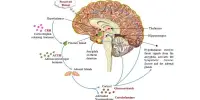Metabolic-associated fatty liver disease (MAFLD) is a growing global health problem with a significant economic impact. A large-scale epidemiologic study conducted in China discovered links between long-term exposure to ambient air pollution and MAFLD. Scientists report in the Journal of Hepatology, the official journal of the European Association for the Study of the Liver, published by Elsevier, that these links are exacerbated by unhealthy lifestyles and the presence of central obesity.
Since the 1980s, the incidence of MAFLD has steadily increased, and it now affects a quarter of the global population and the majority of patients with adult-onset diabetes, posing a significant global burden. MAFLD increased by 40% in Asia between 2012 and 2017. It was previously known as nonalcoholic fatty liver disease (NAFLD), and it can progress to end-stage liver diseases such as cirrhosis and liver cancer, as well as liver transplantation and death.
Animal studies have revealed that breathing air pollutants may increase the risk of MAFLD. Fine particulate matter exposure, for example, may result in nonalcoholic steatohepatitis (NASH)-like phenotype, impair hepatic glucose metabolism, and promote hepatic fibrogenesis.
A growing number of studies have suggested that the most serious environmental problem caused by industrialization, ambient air pollution, may increase the risk of metabolic disorders such as insulin resistance and dyslipidemia, as well as related diseases such as type 2 diabetes mellitus and metabolic syndrome.
Xing Zhao
“The MAFLD epidemic corresponds to environmental and lifestyle changes that have occurred alongside rapid industrialization worldwide, particularly in many Asian countries,” said lead investigator Xing Zhao, Ph.D., of Sichuan University’s West China School of Public Health and West China Fourth Hospital in Chengdu, Sichuan, China.
“A growing number of studies have suggested that the most serious environmental problem caused by industrialization, ambient air pollution, may increase the risk of metabolic disorders such as insulin resistance and dyslipidemia, as well as related diseases such as type 2 diabetes mellitus and metabolic syndrome. However, there was limited epidemiologic evidence for the association, so we conducted this study to improve our understanding of the effects of air pollution on human health and to help reduce the burden of MAFLD.”
Based on the baseline survey of the China Multi-Ethnic Cohort (CMEC), a prospective cohort that enrolled nearly 100,000 participants in southwest China from 2018 to 2019, researchers conducted an epidemiologic study on the potential role of ambient air pollution in the risk of MAFLD in approximately 90,000 adults in China. The CMEC collected participant information, such as sociodemographics, lifestyle habits, and health-related history, via verbal interviews conducted by trained staff, and then assessed anthropometrics, biosamples (blood, urine, and saliva), and imaging data.

Researchers discovered that long-term exposure to ambient air pollution may increase the risk of MAFLD, particularly in men, smokers, alcoholic drinkers, and those who consume a high-fat diet. Unhealthy lifestyle habits and an excess of fat in the abdominal area may exacerbate the negative effects.
“Our findings add to the growing body of evidence that ambient pollution has a negative impact on metabolic function and related organs,” Dr. Zhao and his colleagues said. “However, physical activity did not appear to change the links between air pollution and MAFLD.” Future research should look into whether the timing, intensity, and type of physical activity can help to reduce the harmful effects of air pollution.
Air pollution, according to the researchers, should be recognized as a modifiable risk factor for MAFLD. High-risk populations should be aware of the air quality in their neighborhoods and plan their activities to minimize their exposure to air pollution.
In an accompanying editorial, Massimo Colombo, MD, San Raffaele Hospital, Liver Center, Milan, Italy, and Robert Barouki, MD, Ph.D., University of Paris, Inserm Unit T3S, Paris, France, noted that the assessment of the major determinants of mortality worldwide by WHO showed that global pollution topped the list, ranking higher than smoking, alcohol consumption, and major infectious diseases and that air pollution, the most critical component of global pollution, is likely to be responsible for millions of deaths per year worldwide.
“A better characterization of the liver exosome is expected to improve prevention and precautionary counseling,” commented Dr. Colombo and Dr. Barouki. “Indeed, whereas physical activity combined with a healthy diet is a primary pillar in the fight against metabolic syndrome-related morbidities, including MAFLD, the findings that ambient pollution may exacerbate MAFLD risk may offer new clues to refining the counseling of these patients, for example, by restricting risk populations’ exposure to open-air settings with high levels of pollution, as is recommended for patients suffering from severe asthma. It also serves as an additional incentive for policymakers to accelerate efforts to comply with WHO guidelines and limits on air pollution, like many cities in Europe and around the world continue to exceed those limits.”















